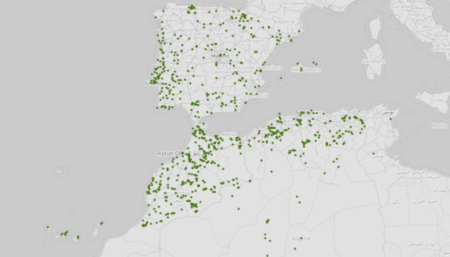- The complex geography of domestication of the African rice Oryza glaberrima. Domesticated in multiple places, and the formerly putative ancestor population unlikely to be so.
- Prehistoric cereal foods of southeastern Europe: An archaeobotanical exploration. Including Panicum millet as far back as the Bronze Age, interestingly.
- Genetic diversity in Ethiopian Durum Wheat (Triticum turgidum var durum) inferred from phenotypic variations. Some landraces are better than some improved varieties, sometimes, somewhere.
- Editorial: Rediscovering Local Landraces: Shaping Horticulture for the Future. See above.
- Enhancing the rate of genetic gain in public-sector plant breeding programs: lessons from the breeder’s equation. What do they have to say about the genetic diversity term, I hear you ask? “For many species, the primary value of exotic genetic variation is the identification and deployment of rare alleles with large effects that can be introduced into elite breeding programs via a thoughtful implementation of marker-assisted selection…”
- The many‐faced Janus of plant breeding. It’s more than just genetics.
- The need for coordinated transdisciplinary research infrastructures for pollinator conservation and crop pollination resilience. Mine historical data and mobilize the citizenry.
- Human disturbance impacts the integrity of sacred church forests, Ethiopia. Even the small forests are important.
- The potential of indigenous agricultural food production under climate change in Hawaiʻi. They could have fed today’s population, and could still do so.
- Managing plant genetic resources using low and ultra-low temperature storage: a case study of tomato. Nothing is perfect.
- A spatial framework for ex-ante impact assessment of agricultural technologies. I do love a map, but I have to wonder if you can have too much of a good thing.
- Why we should let rewilding be wild and biodiverse. Well, why not?
- Increasing impacts of land use on biodiversity and carbon sequestration driven by population and economic growth. The 2008 financial crisis was good for biodiversity.
- Rapid growth in greenhouse gas emissions from the adoption of industrial-scale aquaculture. Crab ponds are worse than paddy fields for greenhouse gas emissions.
- ColourQuant: a high-throughput technique to extract and quantify colour phenotypes from plant images. Remind me to tell you my story about characterizing the colours of a taro collection in Vanuatu.
- Phenotypic analysis of leaf colours from the USDA, ARS sweetpotato (Ipomoea batatas) germplasm collection. Never mind, this story is better.
Vavilov revisited
Jeremy has an interview with Martin Jones on the latest Eat This Podcast. Dr Jones, Pitt Rivers professor of Archaeology at the University of Cambridge, was an author of the paper on the prehistoric globalization of cereals that we blogged about here a couple of weeks back. Well worth a listen.
Brainfood: Goat genotyping, Chinese goats, Ag & nutrition, Biodiversity & yields, Gendering interventions, Fe biofortification effects, Apple in vitro, Chestnut diversity, Seed collecting, Wild potato evaluation, Veggie kits, Soil biodiversity, Sea urchins, Poinsettia
- AdaptMap: exploring goat diversity and adaptation. Strong geographic structuring.
- Insights into the genetic diversity of indigenous goats and their conservation priorities. “…if one breed could survive in changing conditions all the time, the straightforward approach is to increase its utilization and attraction for production via mining breed germplasm characteristic.” If…
- Leveraging agriculture for nutrition in South Asia: What do we know, and what have we learned? To do its part for nutrition, agriculture needs to play nice with other sectors. Here comes the evidence base.
- A global synthesis reveals biodiversity-mediated benefits for crop production. Service-providing organisms really do provide services.
- Intensifying Inequality? Gendered Trends in Commercializing and Diversifying Smallholder Farming Systems in East Africa. Commercialization good for men, diversification good for women. Maybe do both? And more on commercialization.
- Iron biofortification interventions to improve iron status and functional outcomes. Cognitive performance improved, but no effect on iron deficiency or anaemia. So complicated.
- In vitro tissue culture of apple and other Malus species: recent advances and applications. Lots of tinkering still needed.
- Mediterranean and Northern Iberian gene pools of wild Castanea sativa Mill. are two differentiated ecotypes originated under natural divergent selection. One xeric, the other mesophytic. Satisfyingly uncomplicated.
- Guidelines for seed collection of Araucaria angustifolia (Bertol.) Kuntze: A genetic, demographic and geographic approach. Watch out for fragmentation.
- Screening of wild potato genetic resources for combined resistance to late blight on tubers and pale potato cyst nematodes. 5% of about 1000 very resistant. Another 1000 to go.
- Connecting genebanks to farmers in East Africa through the distribution of vegetable seed kits. Distributing 42,000 seed kits with 183,000 vegetable seed samples in 5 years generates lots of questions.
- Role and management of soil biodiversity for food security and nutrition; where do we stand? We stand uncertain is where we stand.
- Genetic Approaches to Improve Common Bean Nutritional Quality: Current Knowledge and Future Perspectives. Not as nutritious as it could be.
- Trophic Cascade in Seaweed Beds in Sanriku Coast Hit by the Huge Tsunami on 11 March 2011: Sea Urchin Fishery as a Satoumi Activity Serving for Increase in Marine Productivity and Biodiversity. Human-intervention-encourages-biodiversity shock. In other news, Japan has a sea urchin fishery.
- Molecular evidence for repeated recruitment of wild Christmas poinsettia (Euphorbia pulcherrima) into traditional horticulture in Mexico. Fancy genotyping shows plants in gardens were transplanted from the wild. Why not just ask the gardeners though?
The crop wild relatives of North America are done
Congratulations to Colin and all the authors and editors.
https://twitter.com/ColinKhoury/status/1106278018618716162
The wheat in Spain grows all over
The researchers were also able to group Spaniards into five genetic clusters. On a map, these groups form five strips running north to south. Those strips line up neatly with history.
I wonder if you’d get a similar pattern looking at crops, say wheat. There’s lots of material in genebanks to play around with.
LATER: Thanks to David Marshall for pointing out that work has been done on barley.
It just needs someone to compare the patterns now. And repeat for other crops.

